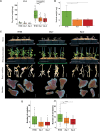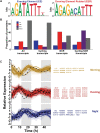Plant circadian clock control of Medicago truncatula nodulation via regulation of nodule cysteine-rich peptides
- PMID: 34850882
- PMCID: PMC8982390
- DOI: 10.1093/jxb/erab526
Plant circadian clock control of Medicago truncatula nodulation via regulation of nodule cysteine-rich peptides
Abstract
Legumes house nitrogen-fixing endosymbiotic rhizobia in specialized polyploid cells within root nodules, which undergo tightly regulated metabolic activity. By carrying out expression analysis of transcripts over time in Medicago truncatula nodules, we found that the circadian clock enables coordinated control of metabolic and regulatory processes linked to nitrogen fixation. This involves the circadian clock-associated transcription factor LATE ELONGATED HYPOCOTYL (LHY), with lhy mutants being affected in nodulation. Rhythmic transcripts in root nodules include a subset of nodule-specific cysteine-rich peptides (NCRs) that have the LHY-bound conserved evening element in their promoters. Until now, studies have suggested that NCRs act to regulate bacteroid differentiation and keep the rhizobial population in check. However, these conclusions came from the study of a few members of this very large gene family that has complex diversified spatio-temporal expression. We suggest that rhythmic expression of NCRs may be important for temporal coordination of bacterial activity with the rhythms of the plant host, in order to ensure optimal symbiosis.
Keywords: Medicago truncatula; Circadian biology; nitrogen fixation; nodulation; plant–environment interaction; symbiosis.
© The Author(s) 2021. Published by Oxford University Press on behalf of the Society for Experimental Biology.
Figures




References
-
- Achom M, Roy P, Lagunas B, et al. . 2022.Data from: Plant circadian clock control of Medicago truncatula nodulation via regulation of nodule cysteine-rich peptides. Dryad Digital Repository doi:10.5061/dryad.9s4mw6mgg - DOI - PMC - PubMed
-
- Adams S, Grundy J, Veflingstad SR, Dyer NP, Hannah MA, Ott S, Carre IA.. 2018. Circadian control of abscisic acid biosynthesis and signalling pathways revealed by genome-wide analysis of LHY binding targets. New Phytologist 220, 893–907. - PubMed
-
- Altschul SF, Gish W, Miller W, Myers EW, Lipman DJ.. 1990. Basic local alignment search tool. Journal of Molecular Biology 215, 403–410. - PubMed
-
- Andrews S. 2010. FastQC: a quality control tool for high throughput sequence data. http://www.bioinformatics.babraham.ac.uk/projects/fastqc.
Publication types
MeSH terms
Substances
Grants and funding
LinkOut - more resources
Full Text Sources

